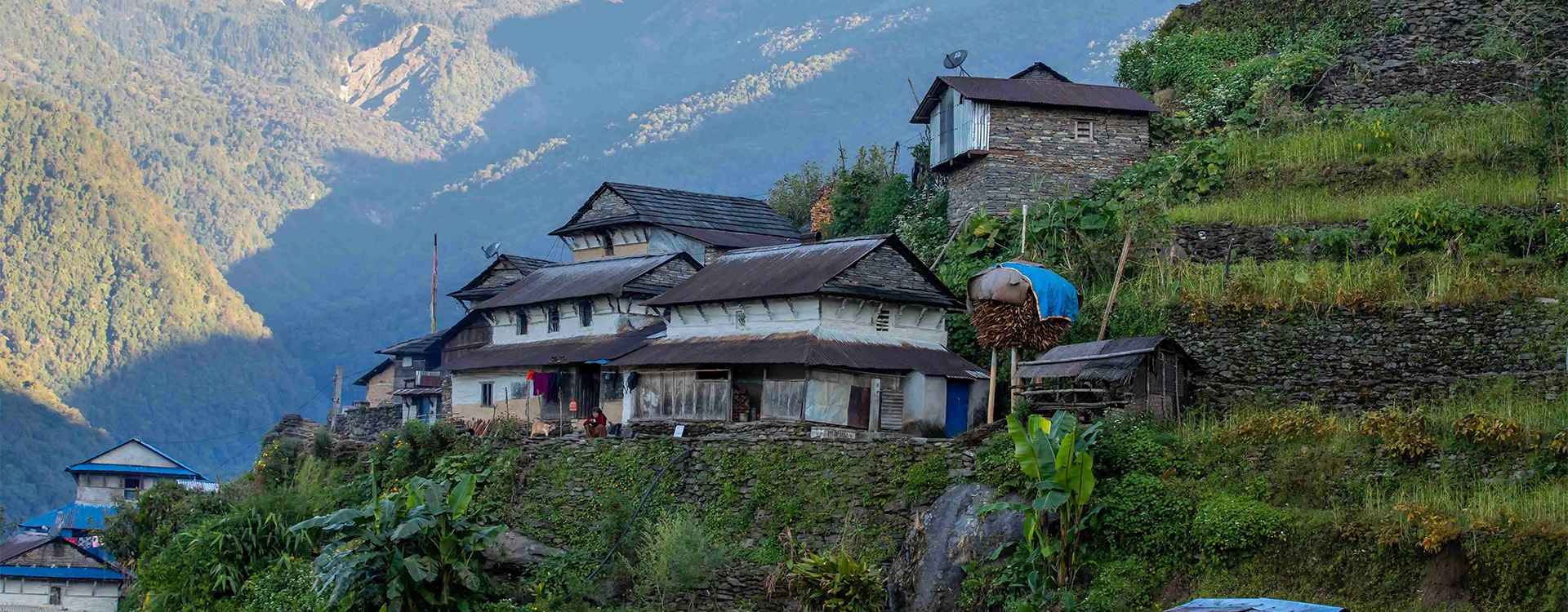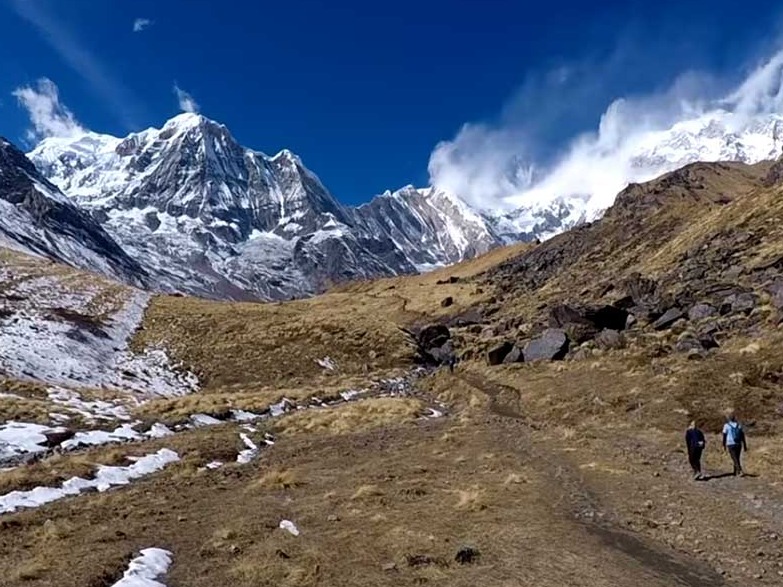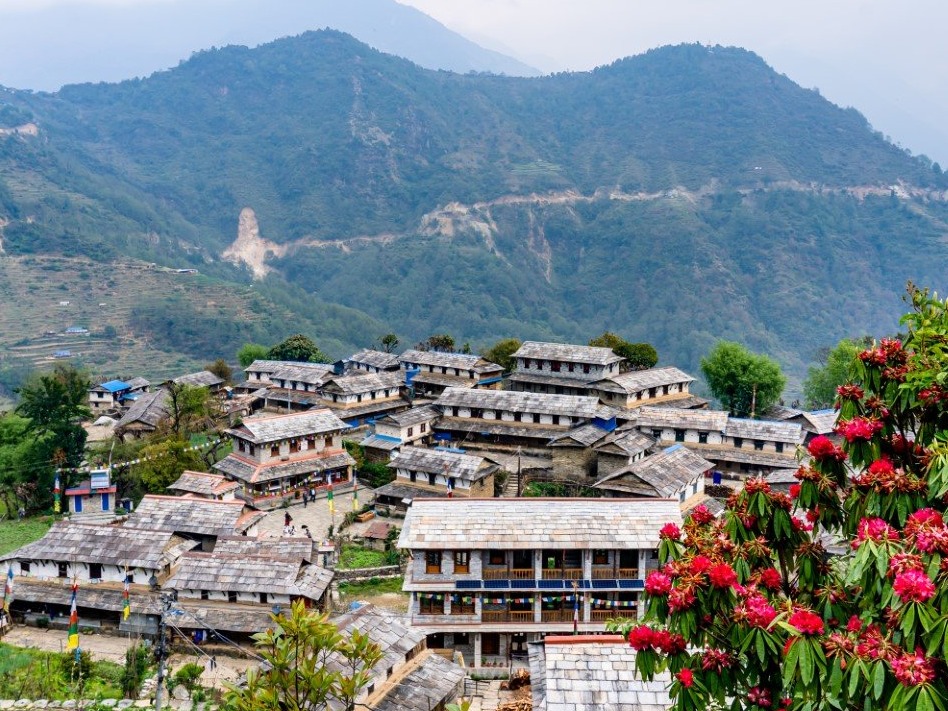- Discover Nepal in a New Way—With Real Homestay
- Why Choose Homestay in Nepal?
- What to Expect from a Nepali Homestay
- Top Destination for Authentic Homestays in Nepal
- Panauti: A Town of Living Newar Heritage (Kathmandu Valley)
- Tansen: Hillside Placidity in Palpa (Western Nepal)
- Chitlang: Organic Living Near Kathmandu (Makwanpur District)
- Ghandruk: Real Gurungs' experience (Annapurna region)
- The Tharu Village: It provides a cultural stay in Chitwan (Terai region).
- Bandipur: Cultural Hilltop Retreat (Gandaki Province)
- Sikles: Traditional Gurung Community in the Annapurna Region
- Rasuwa: Tamang Culture & Himalayan Views
- Bardia: Tharu Homestays & Jungle Adventures
- Tips for Enriching Homestay Experience
- Final Thoughts
- What is a homestay in Nepal?
- Why should I prefer homestays rather than hotels in Nepal?
- Are homestays from countries safe for solo travelers, like Nepal?
- What facilities do most Nepali homestays provide?
- Is the food served in Nepali homestays neat?
- Do Nepali homes serve vegetarians or vegans?
- Can I communicate with my host family in English?
- Are homestays in Nepal heavenly places for children?
- What kind of culture is there at a Nepal homestay?
- Are homestays available in luxury types in Nepal?
- Which are the foremost locales in Nepal to take in authentic homestays?
- From your available knowledge, what are the estimated average expenses for a comfortable stay in one of the homestays in Nepal?
- Will I get to participate in some of the local activities when I am a guest in a homestay?
- Is living in a homestay in Nepal a sustainable method of tourism?
Discover Nepal in a New Way—With Real Homestay
People mainly think about Nepal's snow-capped mountains, green forests, beautiful trekking trails, historic temples, and deep lakes. But here is a different, deeper, spiritual experience in the wait of genuine homestays in Nepal, where traditional and cultural connections are made real. Homestays provide more experience than adventure. Nepalese homestays are operated primarily by households, and they give the most excellent service to you. They give you more than a bed; these homestays treat you as part of the family. Homestays in Nepal are different.
Homestays are diverse in Nepal. Here, there are diverse cultures, traditions, cuisines, and scenery to view! Living in a local home will bring you to understand the various ethnic traditions that make up Nepal- be it Gurung, Magar, Newar, or Tamang- waking up to the smell of freshly cooked dal bhat and engaging with the host family in their everyday lives. In a way, it is almost synonymous with the rest of Nepal in a very honorable way, and not just a travel itinerary meant to cater to the needs of the tourist.
Whether hiking through the mountainous high-altitude region, living life in a valley, or being way off the beaten path for tourist trails, your choice of a homestay centers around sustainable tourism and gives you an authentic local experience. In this blog, some insights will be offered about where to stay, what to expect, and how these enriching encounters can alter your journey—and your perspective.
Why Choose Homestay in Nepal?
Homestays offer better food and experiences than hostels or hotels. In homestays, you feel like a home and you are treated like family members of their own; it makes you feel very good and positive. You will get a chance to interact with the family members and even with the village's people and share meals, stories, and daily life with the local people. Here is why homestays stand out:
Cultural Immersion with Local Communities
Nepal homestays give you an opportunity to see the culture, tradition, and lifestyle of Nepal. You can also learn the local language, their tradition, and culture, and participate in local festivals and family gatherings, too. Witnessing morning puja or helping in fields or domestic work, you'll have sufficient knowledge regarding rural life in Nepal.
Authentic Nepali Cuisine
During the homestay in one's homestead, guests can get a taste of typical Nepali cuisine: dal-bhat, vegetables, soups, pickles, and other side dishes all cooked with utmost love. Local food such as gundruk, sel roti, tama ko tarkari, makai bhatmas, kodo ko dhido, and many more may be offered. It is also normal for most hosts to show their guests how to make the foods mentioned above, which makes the homestay experience even better.
Sustainable and Responsible Tourism
Responsible tourism happens the other way round. Whoever chooses a homestay in Nepal benefits the local economy directly. Money paid to locals stays with the people, heading towards sustainable tourism in Nepal. The homestays empower women, promote traditional lifestyles, and limit the negative impacts of tourism. It is a conscious choice for Nepal's bigger scenario of ecological and cultural heritage.
Off-the-Beaten-Path Adventures
Say goodbye to commercially popular attractions! Contrary to this, the homestays take the path less traveled. They lead you to Nepal's hidden treasures: remote mountain villages, terraced farms, forest trails, sanctuaries, and temples, unbeknownst to the vocabulary of the generic traveler. Trek unknown pathways or amble gently through a quiet village, and you will experience the embodiment of the Himalayas left untouched—Nepal's truest charm.
Interpersonal bonds
A homestay is remembered not just for where it happens but also for with whom you reside. The locals tend to treat the guests as their family and share with them memories, smiles, and their daily existence. You might just develop connections for more than just travel. Many visitors return to Nepal not just for the landscape but to see again their host families.
What to Expect from a Nepali Homestay
Nepal is a paradise with diversity—different cultures are prevalent in different areas, and lifestyles also differ from one another. This in itself is an experience apart from Nepali homestays. But one common thing is their hospitable nature, quality food supplied, and knack to give you the feeling of being at home with warmth that makes them feel like family and not just some guest.
Here are some of the enriching experiences that will come your way if you plan to stay at a traditional homestay in Nepal:
A traditional welcome ceremony
At most homestays, visitors are greeted with a friendly "Namaste," prayer powder, forehead "tika," and a garland of flowers. This makes visitors feel comfortable and also creates a good relationship between visitors and the host.
Rustic Comfort
Homestay accommodations are basic yet clean and comfortable: a private or shared room, a basic bed plus a comfortable Nepali mattress with a blanket and minimal furniture in the room. The building itself is made of stone and mud or wood (this denotes local architecture). Homestays can be deemed luxury (yet they aren't), and they proudly offer homely comforts and an endearing atmosphere unlike any five-star hotel.
Freshly Cooked Homemade Meals
Meals are one of the most delightful features of staying at a homestay. Home-cooked meals—wholly Nepali and prepared using fresh vegetables, grains, and dairy produced by the family farm—come as dal bhat (lentils with rice), seasonal greens, pickles, and often handmade roti or sel roti. Guests, moreover, are generally welcome to partake of the cooking or at least watch, so every meal becomes a form of cultural exchange.
Living the Hard Way: Farming, Cooking & More
In a homestay, probably what you enjoy most is being a part of the whole process of daily life. You rid yourself of the modern concept of "spare-time work," since the variety of work you may engage in depends on the season and the region. For example, you can help plant rice, harvest vegetables, milk cows, or weave traditional dresses- all these experiences offer a rare glimpse into everyday life in Nepal and serve as a cultural bridge by sharing experiences.
Language and Cultural Learning
Locals readily instruct their visitors in some essential greetings in Nepali or, occasionally, even in local languages like Tamang, Gurung, or Newari. Such small interactions can be wonderful and rewarding in reaching out to one on a more personal basis. And don't be surprised to discover that children turn out to be your language tutors, at times religiously practicing their English with you!
Top Destination for Authentic Homestays in Nepal
It is the richness of landscapes and cultures that Nepal itself offers, and such richness can be said to be reflected in true homestays throughout the nation. From Himalayan villages to subtropical Terai, every nook and cranny has something unique in the way of customs, architecture, cuisine, and hospitality that is reflected here. Some of the major local homestay sites of Nepal that combine the nature and warmth of community living with cultural experience are as follows:
Panauti: A Town of Living Newar Heritage (Kathmandu Valley)
Even one hour from Kathmandu, you are hidden beneath a treasure in Panauti. Visit this busy Newar hub and be inclined to its well-preserved Newar architecture, ancient temples, and colorful festivals, which further offer authentic Newari homestays in restored heritage homes.
Activities: Cooking Newari food, temple tours, and joining a festival
Tansen: Hillside Placidity in Palpa (Western Nepal)
Tansen has formed the most important historical hill towns along with panoramic views of the Himalayas, which have a very laid-back atmosphere. It's just the ideal locale for all those slow travelers as regards living up to their nature and culture within their much-enjoyed homestay in Palpa.
Activities: Visit Rani Mahal, explore crafts, and enjoy quiet walks.
Chitlang: Organic Living Near Kathmandu (Makwanpur District)
Chitlang is already coming up as a popular destination for eco-tourism and organic farming experiences, just flanked by green hills and farmlands. Stay in traditional homes where families make cheese, grow their seasonal crops, and offer peaceful walking through the forests and meadows.
Activities: Organic farming, cheese making, hiking to Kulekhani
Ghandruk: Real Gurungs' experience (Annapurna region)
Ghandruk is one of Nepal's most highly sought home-stay tourism destinations. Blessed with rich Gurung culture, terraces, and breathtaking views of the mountains, Machapuchare and Annapurna South, the village is truly for trekkers wishing to fulfill their long dreams for a taste of village life, truly in Nepal.
Activities: dances, weaving, and mountain farming.
The Tharu Village: It provides a cultural stay in Chitwan (Terai region).
Tharu stay provides a beautiful cultural environment for the tourists residing in the Chitwan National Park region. The Tharu people are indigenous to the area and boast rich traditions, dance, and food, along with a deep forest connection.
Activities: Tharu cultural dance, cooking, canoeing, wildlife safari
Bandipur: Cultural Hilltop Retreat (Gandaki Province)
Bandipur is an exquisitely preserved town of Newar, perched on the ridge with great views of the Himalayas. Nested in an environment of narrow streets bereft of traffic and a rich local culture with well-preserved old monuments, Bandipur offers tourists homestays to stay and learn about Newar culture and local crafts.
Activities: guided walks, traditional music, and a sunrise viewpoint excursion.
Sikles: Traditional Gurung Community in the Annapurna Region
On the other hand, Sikles is a Gurung village that lies in the northeast of Pokhara, and it severely rivals very famous locations like Ghandruk. This, however, is better and more private. Terraced field sceneries combined with 360 views allow trekkers and culture enthusiasts to enjoy this destination.
Activities: short treks, Gurung rituals, hand weaving, and mountain views.
Rasuwa: Tamang Culture & Himalayan Views
On the way to Langtang National Park, the Rasuwa district provides homestays that cook up Tamang culture, traditional music, and herbal healing. Several houses here are on the Tamang Heritage Trail, a trek designed around community tourism.
Activities: Participate in Tamang dance, music, and hot springs, and enjoy Himalayan views.
Bardia: Tharu Homestays & Jungle Adventures
With its wild charms, a much more remote experience than Chitwan, Bardia National Park offers jungle experiences richer in wildlife. Tharu village homestays offer the visitor the rare experience of staying at one where the sounds of daily indigenous existence and the jungle merge into each other.
Activities: Wildlife safaris, cultural shows, fishing, and agricultural activities with the local folk.
Tips for Enriching Homestay Experience
Staying in a homestay in Nepal is not simply a means of accommodation but a bottomless pool into which one dives deeply into cultural exchange. To be sure that everything works best for you and you express gratitude to the hosts, here are some handy tips that you can present in a very respectful manner.
Observe the local customs:
Every homestay in Nepal follows cultural values. Dresses should be modest, with shoulders and knees covered in rural and religious settings. Always take off shoes upon entering homes or places of worship. Never show acts of affection in public, and be very sensitive as to what customs allow on celebratory occasions of festivals or rituals. Cultural sensitivity creates trust and enhances the intensity of communication with your host.
Learn some Nepali words:
In any region, speaking a few words in the local language can create significant feelings. Easy phrases like Namaste, Dhanyabad, and Khana mitho cha are a welcome sound; every guest should learn them. These little efforts create sweet smiles, laughter, and maybe an invitation to learn more about Nepali culture. Such efforts say to your host family that you are interested in and would like to engage with them.
Bring a pleasing gift for your hosts:
A tiny gift with deep meaning can speak a thousand words. You can think of taking simple gifts from your home country—for instance, a packet of local tea, some chocolates, stationery, or, if provided, a handmade article. Stay away from anything ostentatious or expensive. The aim is to give a small gift of thanks and cultural exchange, not to show opulence. It is a nice way to say thank you and has a good positive impact on beginning the stay.
Think carefully when it comes to photography:
Nepal deserves to be photographed, but the ethics of photography follow. Asking for permission before taking photos of people, especially of the old, women, and in cultural or religious events, is indeed worth consideration. Watch out for temples and sacred places, as they are often prohibited at times for photography. Respecting personal and spiritual boundaries enriches your experience and shows cultural sensitivity.
Keep yourselves in touch with broadness:
The most genuine participation creates the best homestay experience. Help the hosts in cooking, join in farming, listen to the local stories, and ask about traditions and festivals. The more you mingle, the more you learn about Nepali life, and all of them by learning within yourself how you can adapt and connect across cultures. You will enter this place with all the openness in your heart, and you will carry back memories along with friendships forever.
Final Thoughts
These visits provide not only the beauty of the peaceful Himalayan mountains or the thrill of trekking up and down Nepal's mountains, but even more so, the real Nepalese homestays provide something deeper: they open the doors to the chance to get to know very real people, to see local culture firsthand, and to have a glimpse of the nation from the inside. Such a visit lingered in a languid pace of life, out of the travel map, and was invited to the fold of genuine Nepali life. It's akin to sharing breakfasts, afternoon tea in the courtyard, or swapping stories at sunset under the twinkling night sky; each moment will undoubtedly suck you into the spirit of this great nation.
Beautifully captured moments and all the pictures will not forget the long memory that connects people closer to one another and the world within and outside Nepal. That's the difference a true, meaningful travel path takes between photos and memories. In a world where fast travel becomes the norm, homestays remind us of the reason why slow, local, and authentic travel will always be the most memorable trip of all.
FAQs
What is a homestay in Nepal?
Homestay within Nepal is a form of accommodation where the traveler stays within the homes of local families to provide a real cultural experience with authentic hospitality skills.
Why should I prefer homestays rather than hotels in Nepal?
Homestays were homes in buildings and took on more personal and cultural businesses and community-based letting for experience in the local life, and putting money into responsible tourism.
Are homestays from countries safe for solo travelers, like Nepal?
Most homestays are safe for a single traveler in Nepal, owing to the fact that many host families tend to make their guests feel at home to the greatest extent possible while immersing them in the culture.
What facilities do most Nepali homestays provide?
Expect simple and comfortable rooms, clean toilets, traditional food, and chances to participate in daily activities of farming or cooking with your host family.
Is the food served in Nepali homestays neat?
Yes, food is mostly clean homemade foods that are prepared using fresh and local ingredients. Clients are generally quite sticklers for cleanliness in their food, which is mostly grown on their farms or gardens.
Do Nepali homes serve vegetarians or vegans?
Yes, really. Vegetarianism is a livelihood in Nepal and most of the homestays happily cater to vegetarianism or veganism with traditional plant-based dishes.
Can I communicate with my host family in English?
Most of the homestays speak basic English, even generalizing to tourist regions. However, adding a few phrases of Nepali will add value to the experience and communication.
Are homestays in Nepal heavenly places for children?
Yes, there are many family homestays wherein children can discover the Nepali culture and nature in a safe, informative, and enriching atmosphere.
What kind of culture is there at a Nepal homestay?
Modest dress, shoe removal before entering homes, eating or giving by the right hand, and always seeking permission before taking a photograph are some of the things to follow here.
Are homestays available in luxury types in Nepal?
Most of the homestays have a traditional and simple environment; however, some have modernized the rooms with comfortable basic amenities found in a heritage home or eco-lodge in places such as Bandipur or Panauti.
Which are the foremost locales in Nepal to take in authentic homestays?
Prominent purveyors of homestays include Ghandruk, Panauti, Chitlang, Bandipur, Tansen, the Tharu village cluster in Chitwan and Bardia, Sikles, and the Tamang Heritage Trail in Rasuwa.
From your available knowledge, what are the estimated average expenses for a comfortable stay in one of the homestays in Nepal?
Most homestays in Nepal charge somewhere between $10-$30 per night. Meals are usually included in that price, and there is generally some kind of cultural experience thrown in on the side.
Will I get to participate in some of the local activities when I am a guest in a homestay?
Most homestays have an activity: farming, cooking, weaving, or participating in social events, because it's part of what creates a guest experience and connects it to engagement.
Is living in a homestay in Nepal a sustainable method of tourism?
Yes, it means supporting local communities, cultural perpetuity, and possibly the least environmental impact of travel by visiting local homes for staying.






